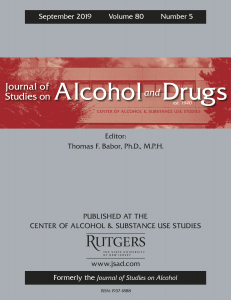COVID-19 Cuts Into College Students' Drinking

PISCATAWAY, N.J., December 16, 2020 (Newswire.com) - When college campuses closed in the spring due to the COVID-19 pandemic, the quantity of alcohol consumed by students decreased significantly if they went from living with peers to living with parents, according to a new report in the Journal of Studies on Alcohol and Drugs.
Leaving home for college is often associated with increases in drinking, and campus closures in spring 2020 formed “the perfect natural experiment” to study changes in drinking behaviors when living situations changed unexpectedly for many students, according to lead researcher Helene R. White, Ph.D., distinguished professor emerita with the Center of Alcohol & Substance Use Studies at Rutgers University in New Jersey.
But according to this study, it might not be just the watchful eye of parents that led to the decrease in quantity of alcohol consumed.
“Drinking is a social behavior for college students, and without social interaction students are less likely to drink heavily,” White says. “Living with parents may especially interfere with social interaction with peers and thereby be protective against heavy drinking.”
White and colleagues surveyed 312 students--mostly college juniors and seniors--two months after COVID-19 campus shutdowns. They asked students about their living situations before and after their schools stopped in-person learning, dividing students into three groups: (a) living with peers before and after closure, (b) living with parents before and after closure and (c) living with peers before closure but with parents after.
The investigators also asked about students’ drinking before and after closure. From these responses, White and colleagues tallied the number of days of drinking per week, total number of drinks consumed weekly and maximum number of drinks consumed in any one day.
Student alcohol users who moved from living with peers to parents significantly decreased the number of days they drank per week, from 3.1 before closure to 2.7 after. However, those who remained with peers increased drinking days from 3 to 3.7 weekly, and those remaining with parents increased from 2 to 3.3.
Similarly, the total number of drinks per week for students who moved home went from 13.9 to 8.5. Those continuing to live with peers drank essentially the same amount (10.6 drinks before compared with 11 weekly after closure), whereas those who continued living at home drank almost three drinks per week more (6.7 before versus 9.4 drinks weekly after closure).
Those who moved from living with peers to living with parents also saw a decrease in the maximum number of drinks in a day--a maximum of 5.4 drinks per day before closure to 2.9 after. But also seeing a decrease were those who remained with peers (4.4 versus 3.7) and those remaining with parents (3.5 versus 3.2) from before to after closures.
“[C]ontext is an important correlate of pandemic-related drinking,” the authors conclude. “The COVID-19 pandemic is a time of increasing social isolation,” which, for students who move home, “provides fewer social opportunities for drinking.”
Contact:
Helene White
hewhite@smithers.rutgers.edu
Source: Journal of Studies on Alcohol and Drugs
